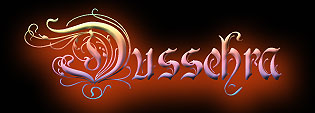Every
year around September, the monsoon clouds slowly disperse, the heavy showers slacken
to a light drizzle and the skies turn from shades of dull grey to a light, clear
blue. A feeling of expectancy fills the air and everyone looks forward with eagerness
to the coming season of festivities. The first of these is Dussehra.
As with
many festivals Dussehra symbolises the triumph of good over evil and is celebrated
in several ways throughout the country. The festivities last ten days and nights,
the first nine nights of which are the 'Navaratri', dedicated to the worship of
different aspects of Durga in some areas and also of Lakshmi or Saraswati in others.
In north India all ten days of Dussehra are publicly dominated by the Ramlila,
vivid enactments of episodes from the Ramayana that culminate with the burning
of effigies of Ravana and the triumph of Rama.
We are all familiar with the
story of our earliest Epic the Ramayana. The noble Prince Rama and his younger
brother Prince Lakshmana went to rescue Princess Sita who had been kidnapped by
the demon-King Ravana of Lanka.
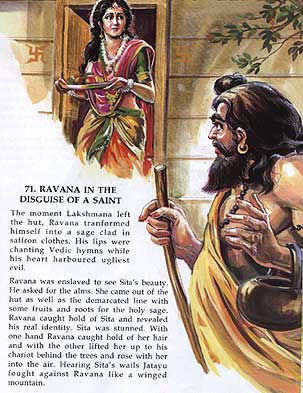
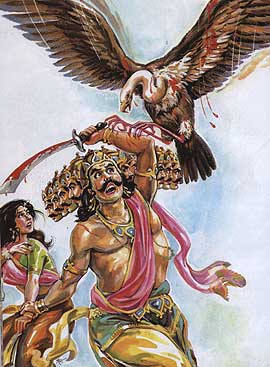
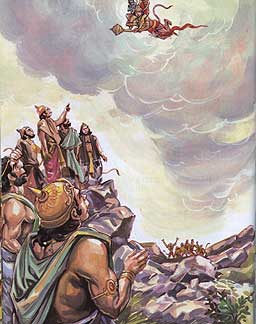
They were aided by the monkey General Hanuman, and his army of monkeys and bears. For ten long days the battle raged fiercely.
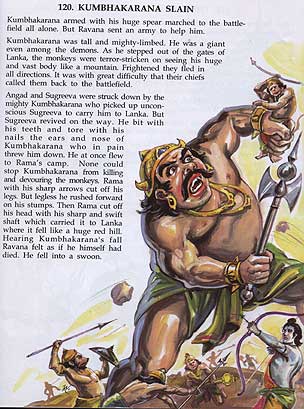
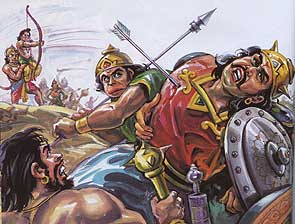
At last, Meghnath (Indrajit -above), Ravana's son, and Kumbhkarna, his brother and finally, King Ravana (below) himself were killed, and Prince Rama was victorious. Sita was rescued and joyfully united with her husband and they all flew back to Ayodhya, asthe years of exile were over.
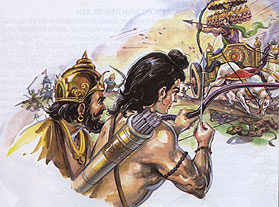
The
annual enactments of the Ramayana are the result of much devotion and enthusiastic
planning. As soon as the rains are over and the harvest cut and stored, everyone
begins preparations for the play.
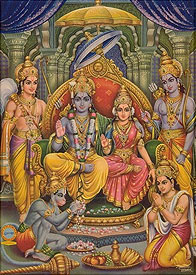
In
villages, the panchayat (village council) collects money from each household for
its local mandali (group of players). The mandali begins rehearsing the actors,
preparing costumes, and other properties—crowns, masks for the monkey-and
bear-soldiers or the demons of King Ravana's army, and bows and arrows. They also
erect a stage in the village maidan. Each evening of the ten days the major events
of the Ramayana story are enacted and on the final day three huge bamboo and paper
effigies of Ravana, Meghnath and Kumbhkarna, stuffed with fire-crackers, are set
alight. They blaze and crackle in fiery splendour, till finally the huge figures
fall and are stilled; once again the wicked rakshasas have been overcome by the
noble Prince Rama.
In big cities, each large suburb has its own local committee
which collects funds for the play. Actors are chosen from among those who live
in the locality, although these days, well-known professional actors may be invited
to play the major roles of Rama, Ravana or Hanuman. Women do not take part in
the traditional Ramlila and Sita's role and those of other women are usually played
by young boys who dress up in ghagras or saris and use make-up. They specially
enjoy the part of the wicked rakshasi Shurpanakha and painting their face into
a hideous, frightening mask!
In Delhi the final day of Dussehra has become
a festival of national importance. The large Ramlila grounds make a fine setting
for the celebrations. The effigies of the three rakshasas are very large—about
120-150 feet high—and they are filled with thebrightest and best quality
fire-crackers. Each year new theatrical tricks are devised and at the 1978 show
Hanuman, who seemed to be as good an acrobat as an actor, flew high above the
heads of the spectators, suspended on a wire!
Whether we live in a city or
village we have all seen and sometimes even taken part in these annual celebrations.
But few of us have had the chance of being present at the finest Ramlila of all—that
held near Varanasi across the river Ganga at Ramnagar.
The Ramnagar Ramlila
is a truly remarkable event. It is more than just a play; it is more like a great
religious ceremony in which thousands of people participate. The lila (play) lasts
for thirty days, and was first begun over a hundred years ago by the Maharaja
of Benaras. It has been continued by his descendants who still live in the palace
within the fort in the city.
The Ramnagar Ramlila is based on the sixteenth
century poet-saint Tulsidas' Ramayana known as the Ramacharitmanas. This is the
best-known and much loved Hindi variation of sage Valmiki's original Ramayana
which was in Sanskrit. The entire poem of Tulsidas is in chaupais (verses of four
lines), which are sung in a particular way—a sort of sweet lilting chant.
The chaupais not only tell the story, but also contain the lofty thoughts of the
poet-saint who was a great devotee of Lord Rama's. Few people can listen to the
Ramacharitmanas without being deeply moved, at times even to tears.
The Ramnagar
Ramlila begins with the gods pleading with Lord Vishnu to save the earth from
the terrible deeds of the wicked demon-King Ravana. So Vishnu is born on earth
as Prince Rama to carry out his divine purpose. Every part of Ramnagar is used
for different scenes in the play. Just outside the palace is 'Ayodhya', where
the early scenes of King Dasrath'scourt are shown. Then when Prince Rama is exiled,
he, Sita and Lakshmana go to the 'forest' which is far from the palace in the
surrounding countryside. And as they are carried out, dressed as hermits, the
entire audience walks behind them, with priests chanting the chaupais of those
scenes.
'Lanka' is the great big maidan of Ramnagar, while 'Ashokavatika',
where Sita sits imprisoned, is in a corner of the grounds. The audience walks
from one place to another as the scene shifts. If a chariot has to be pulled during
a scene, as when Rama and his party return to Ayodhya in their uran khatola (since
it cannot be shown flying, it is on wheels) the spectators lend a willing hand,
and pull it all the way from 'Lanka' to 'Ayodhya'!
The scenes of battle are
the most exciting. Imagine a huge open ground. In the centre is a big stage. On
one side sit Rama and Lakshmana, who are played by young and beautiful Brahmin
boys, about twelve years old. Their faces are decorated with painted dots and
shiny sequins, on their heads are exquisitely made crowns, their clothes are beautifully
embroidered and they carry bows and arrows. Behind them sits the Vyas—the
pandit, who helps them with their lines, as it is impossible for anyone to remember
a thirty day part, faultlessly! Across the stage, on the farthest side, are three
huge effigies of the rakshasas, and in front of the effigies are the actual actors
who play the roles of Ravana, Meghnath and Kumbhkarna. Around the stage is an
enormous mass of people, over 100,000 of them, the men on one side and the women
in a group on the opposite side. The group of chanting pandits who sing the Ramacharitmanas
sit together with the book open in front of their leader. Two flaming torches
light up the singers. The chief guests are seated on three or four elephants with
gaily painted howdahs, just behind the singers.

Hanuman,
wearing a big painted red mask, and his army come onto the stage. Opposing them
are the demons. They shoot arrows at each other. The monkeys in red masks and
bears in blue masks, are played by children of families of Ramnagar, and you can
imagine how eagerly they look forward to being chosen for this honour. The demons
wearing horrendous, frightening masks—with bulging eyes, blood red tongues
hanging out of mouths full of tusk-like teeth, pointed ears and horns—are
played by grown-ups. The antics of the monkeys and bears, as they shoot the demons
make the audience laugh. And when a particularly evil-looking demon finally falls
down the audience cry out, "Ram Ram Jai Sitaram!" But the loudest cries
are saved for the big battle between Rama and Ravana. When Ravana is finally killed,
the actor lies down, a man lights the fire-crackers inside the largest effigy
and the giant figure goes up in flames, shooting stars into the dark night. Then
the shout "Jai Sitaram" reverberates from the entire crowd.
The following
evening is 'Bharat Milap'. Prince Bharat and his courtiers come to the banks of
the river, cross over and the moving scene of the meeting of the brothers takes
place. They all return across the waters, the entire audience follows—they
are now not dwellers of the twentieth century but citizens following their noble
prince, citizens of Ayodhya in the days of 'Rama Rajya'. Thus a wonderful synthesis
of history, culture, and religion takes place. It is a strange and wonderful happening.
On
the last day everyone joins in an arati-puja celebrating the coronation of Sri
Rama as king and the victory of good over evil.
The final day of Dussehra is
over, but do you think children in north India have finished with their fun? Not
a bit of it! The noise of 'bombs' and crackle of sparklers continues. For, yousee,
Diwali, the Festival of Lights, is round the corner and for all those who are
young at heart, the fun has just begun.
*****
In Tamil Nadu, Dussehra is
known as Navaratri (nine nights). Three nights are dedicated to Goddess Lakshmi,
three to Shakti or Parvati, and three to Saraswati. Every home has a kolu, a decorated
stepped platform filled with toys and clay figurines, representing gods, goddesses
and animals. Also included in the kolu is a kalasam (a silver, copper or clay
vessel with a coconut in it, representing Goddess Durga). Every evening, women
visit each other's homes, and sing and dance in front of each other's kolu. On
the ninth day of Navaratri Saraswati Puja or Ayuda Puja is performed when books,
professional implements etc. are kept in puja: a scholar will keep his books,
a farmer his plough, a carpenter his saw etc. and everyone refrains from practising
their profession that day. The next or tenth day, is Vijayadasami, when people
rededicate themselves to their profession. Vijayadasami is also the day of Vidyaramba
(beginning of study) when children usually begin learning the alphabet.
In
Karnataka, Dussehra is the most important festival of the year. Devotees assemble
in thousands at the grand temple of Chamundeswari on Chamundi Hill. Chamundeswari
(Durga) is the presiding deity of Mysore city. The city, freshly painted and decorated,
and colourful with temporary bazaars has a gay, festive look. In Kerala on the
other hand, it is a minor festival with Hindus quietly celebrating Ayuda Puja
and Vijayadasami in their homes.
article by Uma Anand (courtesy 'Festivals
of India)
